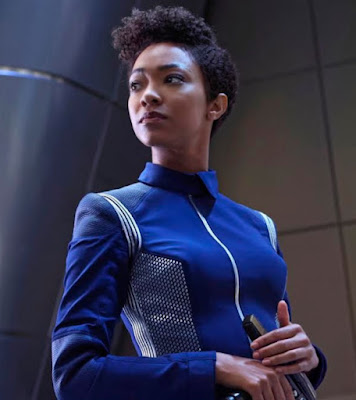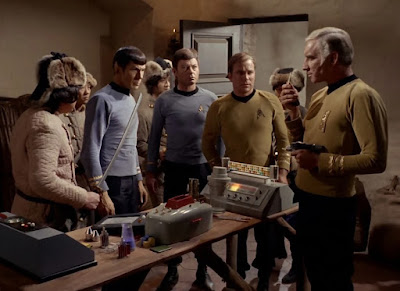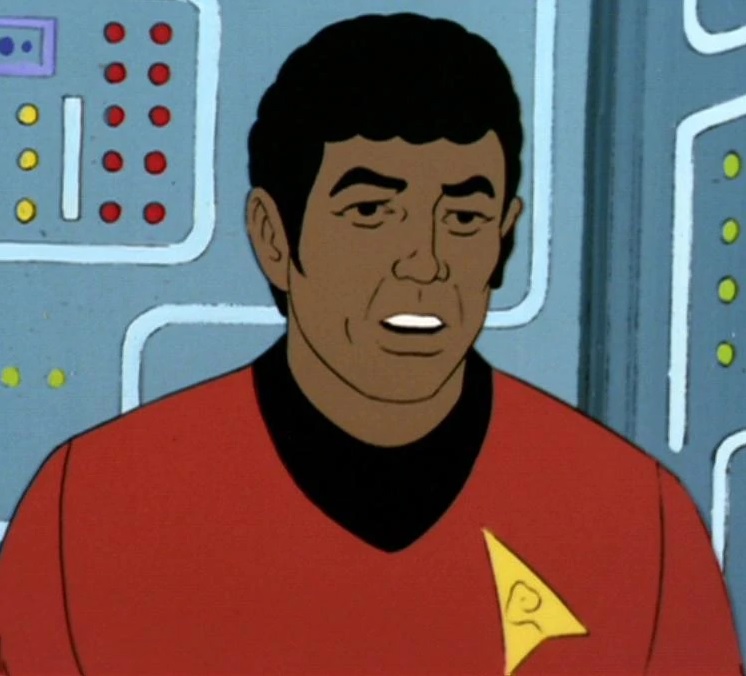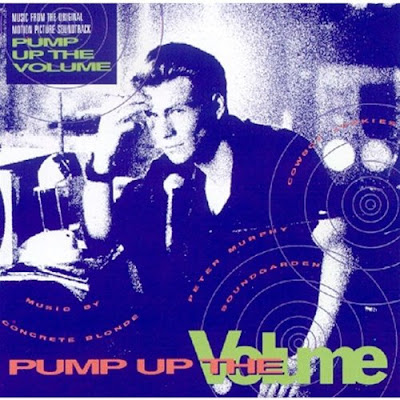One of the things I have always loved about Star Trek is its diversity. The original series was produced during the Civil Rights era and one of the regular characters was Lt. Uhura, a black woman. The U.S. was also embroiled in a bloody land war in Viet Nam and right there flying the ship was an Asian, Lt. Sulu. The Cold War was ratcheting up and for two of the three seasons, sitting next to Sulu was Ensign Chekov. The captain was a Mid-Westerner, doctor was a Southerner, the engineer was from Scotland and the first officer was not even from our planet. Trek has always tried to be inclusive. Sure, if you look back at it today it can be painfully sexist, and those racial minorities rarely had lines that were more than functional, but they were there and treated with respect. If you look at it as a product of its time it was (pun intended) lightyears ahead of just about anything else on television. As times changed so did the show, but it was always striving (even if it sometimes fell short) to include more underrepresented people, not just in casting, but story content as well frequently addressing social issues.
 |
| Uhura from the original Star Trek. |
There has been an ugly strain of racism rearing its head in fandom the last half decade. The political vocabulary of the extreme right has been popping up more and more and when Trek returned to tv with Star Trek: Discovery, immediately charges of being “woke” jumped out. “Oh, they are doing agenda tv with a black woman as the star,” or “Oh they are pushing the gay agenda with a gay regular.” It was nasty hateful shit that made me wonder, if they had been watching the same show that I spent my virtually my whole life watching and re-watching. Whenever I would push someone by asking “what do you mean by “woke?”” invariably what would eventually come out would be racist, sexist, or homophobic.
Every.
Single.
Time.
If “woke” means more representation to actors of color, more gender equitable roles and increased visibility of LGBTQ+ characters and performers, then I’m all for it. Everybody deserves representation. Everyone NEEDS representation. The problem is right wing media is trying to play on the racism of its consumers to generate fear and outrage so they will knee jerk defend the Nazi’s chanting “Jews will not replace us” in Charlottesville and condemn Black Lives Matter as a violent organization even though the FBI reports 93% of BLM protests were peaceful (and most of the remaining 7% were instigated by counter protesters and the Department of Homeland Security reported that white supremacists groups were a larger threat to security).
PART 2: ASSUMPTIONS MADE
This is where it gets fuzzy, the writers and producers of Discovery were not helping. You see, I don’t like Discovery very much. It is literally the bottom of my list when I order my Star Trek series. Whenever, I voice this opinion and two things happen, I’m accused of being racist, homophobic, or sexist which causes the racist, homophobic, misogynists start defending me.
 |
| Burnham from Star Trek: Discovery |
My big gripe about Discovery, being a longtime fan, was the horrid continuity and lazy writing. Plot twists were painfully predictable. (For the record I had the exact same feelings about Star Trek: Enterprise during its first two seasons) I won’t go into details for fear of getting too far off topic, but I hope someday to do an analysis of Discovery and vent my frustration with the show.
But here is the problem…
Every time I had a criticism of the show, the progressive fans who liked the show didn’t seem to want to take my word that my issue is with continuity or the writing, and the conservative half-wit anti-woke crowd wanted to graft their hate onto my complaints to try to legitimize their positions.
Both sides ignored it when I pointed out that Tig Notaro’s Jett Reno had become my favorite character, just edging out Anthony Rapp’s Paul Stamets (whose character and performance is literally the only thing that kept me from quitting the show the first season). Both performers and their characters are gay. Blu del Barro’s non-binary Adira Tal is probably the most important character to be added to a Trek cast since Roddenberry put Nichelle Nichols and George Takei in the original cast. Other than the production values (which will always improve as technology improves) THAT is what Discovery gets right: Representation. They have a fantastically diverse cast of regulars, guest stars and recurring characters. It is one thing that I absolutely love about the show. In fact, I find myself wishing some of the supporting players would get more to do (especially Patrick Kwok-Choon who plays Gen Rhys and Oyin Oladejo who plays Joann Owosekun).
Continuity is important. It provides a sense of verisimilitude. When a continuity issue pops up it makes me crazy. It always has. When a line from Picard in Star Trek: The Next Generation’s pilot “Encounter at Farpoint” blatantly contradicted a line of dialogue from Spock in the original episode “The Omega Glory.” I cringed. I still do. It takes me out every time, even after all these years. The vast majority of continuity errors are usually errors that slipped through. Little errors that could have been fixed with a line of dialogue. Sadly, some are deliberate choices made by the showrunners. To me it's a big issue.
INTERLUDE: REBOOTS VS. SPINOFF AND STRANGE NEW WORLDS & THE ANIMATED SERIES
I know this next little bit will seem off track and even random at times, especially when I said the continuity and writing are, in essence, a whole different issue from all of this, but context is king so I need to discuss some terms and provide some back story before I move on to the real point of this article.
There are three ways to add onto a franchise.
 |
| The Battlestar Galactica hard reboot. |
The THIRD option is the soft reboot. You set it in continuity but devise a way to wipe the slate clean, so you have an excuse to not beholden to continuity. The Star Trek trilogy films starring Chris Pine (2009-2016) are an example of this. Spock from the original prime universe continuity goes back in time chasing a Romulan villain and the timeline gets altered creating an alternate parallel timeline for the new stories.
 |
| Kirk from the Star Trek soft reboot. |
No one is forcing you to like the soft or hard reboots, but they are a tool for writers to get away from being hemmed into continuity. If we did a hard reboot of Trek we could drastically change things up and have a female Latinx Capt. Kirk, a Black Dr. McCoy or a female Scotty, and Spock could be red and eat via a plate in his stomach (as originally intended) but in the soft reboot we must have the characters be mostly recognizable unless the change can be traced back to the plot element that altered things (in this example the timeline changes by the Romulan). Discovery producers deliberately decided the show would be set not in the soft reboot continuity, nor a brand-new hard reboot continuity but instead insisted it was part of the original prime continuity.
During season two of Discovery the story arc tied into the original failed 1964 Star Trek pilot, “The Cage.” (In 1965 a new pilot was made, and the series was sold becoming the show we all know, and the original pilot footage was used as flashback material for the two-part 1966 episode “The Menagerie.”) On Discovery, they recast characters that appeared in that original pilot (Spock, Capt. Pike and Number One) and fan reaction was so positive that a new series, Star Trek: Strange New Worlds, was announced and would be set between the two original pilot episodes in the original prime universe. The show premiered May 5th.
 |
| The Cage characters in Star Trek: Strange New Worlds |
In 1974 Star Trek’s first ever spin-off, Star Trek: The Animated Series was made and ran for two years. It won an Emmy for Best Series in 1975. It helped keep Trek alive in the decade between the cancelation of the original series and its resurgence as a motion picture series. When Star Trek: The Next Generation was on the air, there was a time when TAS was considered non-canonical. However, over the years more and more references from the movies, TNG, Star Trek: Deep Space Nine, Enterprise and most recently Star Trek: Lower Decks have brought it into continuity.
 |
| Star Trek: The Animated Series |
What do these things have to do with one another? You’ll see because now I’m finally at the point of this whole post.
PART 3: THE SPIN OFF, RECASTING AND ACCUSATIONS OF RACISM
Recently it was announced that a black actor had been cast as Admiral Robert April a reoccurring guest character for Star Trek: Strange New Worlds. And of course, some red hat wearing asshole complained online that it was another example of modern Trek being “woke” ruining Trek because the character had previously been established in the TAS as white. He was roundly and properly taken down. Again, in *my* experience EVERY TIME someone uses the word “woke” pejoratively and they have been questioned or pushed on it, it reveals a racist, homophobic or sexist sentiment.
 |
| April from Star Trek Strange New Worlds |
 |
| April from Star Trek: The Animated Series |
Here’s the problem: I agree that the actor should not have been cast but for different reasons. You see: Objecting to the casting of an actor of color because it’s “woke” is racist. However, objecting to recasting of ANY established character that is supposed to be in the same continuity (not a hard reboot) by someone of a different race or gender is not racist because the reasoning is not based in hate but a desire for continuity.
My fellow liberals pounced and proclaimed me a racist. Maybe I am. Maybe I am unconsciously using continuity as a shield. I'm self reflective enough to at least consider the possibility. However, if I were, certainly it would come out in other ways, right? So, I started asking myself questions. It’s always good to ask oneself questions when you find human garbage in agreement with you.
Do I object to a person of color being a high-ranking officer to whom a white man must answer?
No. I never questioned that Commodore Stone, Admiral Morrow or Admiral Cartwright as Kirk’s commanding officers in “Court Martial,” Star Trek III: The Search for Spock and Star Trek IV: The Voyage Home. I would not have a problem if the actor in question were hired to play Admiral Smith instead of Admiral April and served the same function in the story. In act after finally seeing the first episode, there was absolutely no reason to call the character Robert April. By the way, DS9, which featured a black commanding officer, is my favorite Trek series. For whatever, that's worth.
 |
| Sisko from Star Trek: Deep Space Nine |
Would I still object if the situation were reversed?
Oh, you betcha. If April were originally depicted as black in TAS and they announced a white actor playing the role I would be against the casting. I would also object if black characters like Sisko, LaForge, or Mayweather were recast with white actors. Hell, I would be object if Arex, an orange skinned three-armed alien from TAS, were depicted in live action as purple with four arms.
 |
| Arex from Star Trek The Animated Series |
Would I object if the casting was part of a hard reboot?
Nope, not at all.
Is the continuity of his race the only thing about the announcement that bothered me?
Nope. He’s listed as Admiral but the character as he first appears on TAS is a lower rank, a Commodore, in an episode that takes place more than a decade later. Also, I don’t know how old the actor is, but he looks much younger than 60 (April was 75 in his appearance on TAS).
The answer to these questions satisfied me, but every racist I’ve run into has sworn up and down they were not racist, so maybe I’m fooling myself. Again, I'm self reflective enough to consider the possibility. I do know that when pointed these positions out, sadly, my fellow liberals gave me ZERO benefit of the doubt and even went so far as to move goal post and start downplaying the series. Their counter arguments were frequently rude, ill conceived and had the whiff of desperation. Here is a tase of how many conversations went...
I would not want one-time characters of color like Boma (“The Galileo Seven”) and Shea (“By Any Other Name”) recast as white, in fact you can make the same argument about Pike and Number One when they were first used as guest stars on Discovery. They tried to keep those characters like their original interpretation. They even dyed Rebecca Romijn’s hair to match the original actress. There were no accusations of hating blonde’s or accusations being secret brunette supremacists. After finally seeing the first episode, it appears that April is not the only character whose race is changed. Transporter Chief Kyle, who was originally a white British officer, is now Asian with no trace of a British accent. Kyle was not a one off but a reoccurring character who appeared in nine episodes of the original series and even one of the feature films.
 |
| Boma from Star Trek "The Galileo Seven" |
 |
| Shea from Star Trek "By Any Other Name" |
“Boma and Shea were live action. April was a cartoon.”
 |
| Mariner and Freeman from Star Trek: Lower Decks |
“The Animated Series is over 40 years old, Lower Decks is new.”
Eh, so what? Strange New Worlds is literally based on a pilot that is almost 60 years old.
Yea. So is TOS which is the basis for everything, all the shows get older every year. Is this a suggestion that we put “expiration dates” on the shows? TOS and TAS have “expired” since they are over 40 years old. TNG is 35 so we can start ignoring it in five years. This is lame, if the producers want to ignore old stuff, all they had to do was a reboot instead of putting it in the original continuity.
“The Animated Series not cannon. Roddenberry said so.”
It wasn’t… until it was. As I noted above. The show and the episodes have been brought into continuity by other series, some as recently as just last year. The context of Robbenberry comment was that if he knew the show would become a franchise and continue with movies and TNG he would have toned down the sillier elements. With that said, Roddenberry proudly put his name on the series. Seven members of the cast returned to voice their characters (William Shatner, Leonard Nimoy, DeForrest Kelley, James Doohan, Nichelle Nichols, George Takei, and Majel Barrett), as did guest stars (Mark Leonard, Roger C. Carmel, and Stanley Adams) many episodes were written by people who worked on the original series including TOS story editor D.C. Fontana, David Gerrold, Samuel Peeples, Marc Daniels, Margaret Armen, Stephen Kandel and Walter Koenig. It has some pretty deep cred on the creative side, more so than just about any other Trek tv show.
“The writer of the original animated episode is ok with the casting.”
Yes, Fred Bronson (who wrote the episode under the name John Culver) tweeted support for the casting. Given that he might be savaged and accused of racism if he didn’t, it may have been his only choice. There is some debate as whether or not he created the character. Bronson has said he created the character using the name April because he knew Gene liked it (Gene used the name before in other scripts). Conversely, Roddenberry did make the claim at conventions that he created the character because wanted the Enterprise to have "a history" and used a rejected name for the series lead as the first commander/backstory (I heard him say this myself in 1989). Either way the name first appeared to the public in the 1968 book The Making of Star Trek by Roddenberry and Stephen Whitfield as well as an early as a pilot script draft dated March1964, more than a decade before "The Counter Clock Incident" was written. However, that does not necessarily contradict Bronson's recollection, since that point the character was the character that would become Pike. If he did create the character let's hope he's getting the residuals for the use of his character.
 |
| Bronson's Tweet. |
“The episode sucks.”
Yea, so what? The first episode was filmed in 1964. There have been 12 television series (five of which are currently in production) resulting in 861 episodes (including all ten episodes of SNW this season and the yet unaired 10 episodes from this season of Star Trek: Prodigy) with another 50-60 episodes in various points of production for next season and 13 motion pictures (with one in preproduction). When you produce that much material there are going to be some winners and some stinkers. You must take the good with the bad, it wasn't the first ridiculous episode nor was it the last. Continuity and cannon should not be based on a score from Rotten Tomatoes.
“The Animated Series sucks.”
That’s your opinion. The Television Academy of Arts and Sciences disagrees, they gave it a Best Series award. It remains the only Trek to earn that distinction. By contemporary standards it’s dated, cheap looking and may not be your cup of tea, but just because YOU don’t care for it doesn’t mean should be ignored.
“You hate the actor.”
No. I’m completely neutral on the actor. He did a perfectly good job in the first episode as had the actor who has been playing Kyle. I know nothing about either one of them and to the best of my knowledge I have not seen either of them in anything else (If I did, they flew under my radar). I would have no problem if they were presented as new/different characters with different names or the series was a hard reboot.
 |
| Kyle from Star Trek: Strange New Worlds |
 |
| Kyle from the original Star Trek |
“You hate Strange New Worlds”
Given the continuity on Discovery, I’ll admit was very concerned about SNW, but I wanted to love it. I wanted it to be good. I hoped it’s the best Trek ever. This is usually my attitude about every new Trek show before it airs. Since seeing the first three episodes I am of two minds. If it had been presented as a reboot I would hail it as a fantastic start with potential to be one of the top three Trek series, but as a prequal, the numerous continuity issues are distracting and annoying, leaving me very divided. My only real non-continuity related issue with the first episode is some of the cringe worthy Vulcan dialogue near the beginning of the episode.
“It’s clearly racial, you didn’t throw a fit when April was erased from continuity in the Star Trek 2009 film.”
That was a soft reboot. He wasn’t erased, the timeline was altered. His new fate was depicted in the comic book story “Countdown to Darkness” which is considered cannon by the reboot trilogy producers (one of the rare exceptions for a comic or novel).
 |
| April from the soft reboot comic. |
“It’s clearly racial, you don’t have other continuity complaints.”
No, the announcement of the actor happened before the show aired creating the initial controversy and conversation, in addition to the two instances of changing of existing characters ethnicity, I counted at least 12 other continuity issues in the first episode alone after finally seeing it. More have popped up in the two episodes since then. All of which would be non-issues if the show were a reboot instead of a prequel.
“Your reboot argument sucks. People hate reboots.”
Yes… and no. Many hated the hard reboot of Battlestar Galactica and the soft reboot of the new Star Trek film trilogy. But many people LOVED them. You can’t please everyone but why deliberately antagonize and alienate longtime fans by disregarding continuity when it could be avoided one way or the other?
 |
| Star Trek: The Next Generation - "The Outcast" |
 |
| Star Trek: Deep Space Nine - "Rejoined" |
PART 4: CONCLUSION, THE POLITICS OF IT ALL
Here is the thing.
Yes, there is racism. Yes, since Tump’s election, racists have become emboldened. Yes, conservative media is fueling the outrage machine and stoking fear and hate especially in terms of race and the LGBTQ+ community. And yes, racists will sometime lie and try to use non-racial arguments to further a racist agenda or even change packaging to make the racism more subtle or palatable (all you must do is listen to one of Nixon’s advisors, Lee Atwater, discuss the “southern strategy” on YouTube to hear that clearly: https://www.youtube.com/watch?v=X_8E3ENrKrQ). That’s all absolutely true.
However, if you always assume that someone disagreeing with you is evil and racist, then you are as bad as the jerkoffs who scream “woke” every time a person of color or member of the LGBTQ+ community is cast in a movie or a series. It’s ok to be skeptical, most of these hateful pricks are disingenuous blowhards, but ask good faith questions and listen, really listen, and think about the responses, look at their profiles and their past posts. If they are feeding you a line, it will be mostly apparent but otherwise you may be attacking an ally who just has a difference of opinion and not for the reason you suspect or assume.
One thing is for sure. Knee jerk reactions like this will sway people in the political middle. The people who don’t actively go out an advocate for racial diversity or LGBTQ+ inclusion but likewise are appalled by hate groups and would find any effort to impede advancements in those areas distasteful. Maybe the person is a fan who loved The Animated Series, perhaps it was their introduction to Star Trek as a whole. If they agree with the bigoted knuckle dragger but for completely different reasons and they see the brutal attacks on social media. They will walk away thinking, wow, maybe Tucker Carlson, Alex Jones and Laura Ingram are right about all these extreme “woke” liberals. And if they are right about that maybe they are right about vaccines, January 6th, and etc.
This will be catastrophic for the mid-terms and our country. I despise the anti-woke crowd and make no mistake the right wing can’t run on their positions, because they don’t have a record to run on, all they have is the culture war and misinformation and they will be running on the four table legs of a platform that includes nonexistent Critical Race Theory in schools, Transgender bigotry, blaming Democrats for pandemic and corporate greed induced inflation and the ginned-up idea of the “woke” left extremists. With the GOP passing laws that allow people maneuvered into place to over turn election results they don't like, passing restrictive voting laws for those they don't want to have a voice, gerrymandering maps and packing the courts. Democracy is literally on this line this midterm and you are helping them by automatically lumping everyone who disagrees into the same basket of deplorables.


































